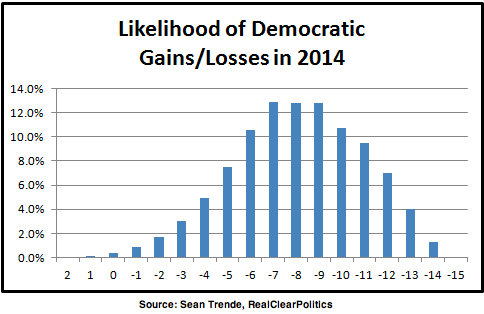
Pew Research explores the structure of Twitter conversations and explains why it matters. Sean Trende predicts pain for Senate Democrats in 2014. And want to get Helvetica on Buzzfeed's "What Font Are You?" quiz? We've got the secret answers. This is HuffPollster for Thursday, February 20, 2014.
MAPPING TWITTER NETWORKS - On Thursday, the Pew Research Internet Project released a study of the nature of Twitter's "conversational structures," based on a massive analysis of tweets since 2010. They identified six unique structures, one of which should be familiar to anyone who follow political news. "If a topic is political, it is common to see two separate, polarized crowds take shape. They form two distinct discussion groups that mostly do not interact with each other. Frequently these are recognizably liberal or conservative groups. The participants within each separate group commonly mention very different collections of website URLs and use distinct hashtags and words...At the center of each group are discussion leaders, the prominent people who are widely replied to or mentioned in the discussion. In polarized discussions, each group links to a different set of influential people or organizations that can be found at the center of each conversation cluster."
The polarization of politics is just one of six types - More from Pew Research: "The Polarized Crowd network structure is only one of several different ways that crowds and conversations can take shape on Twitter. There are at least six distinctive structures of social media crowds which form depending on the subject being discussed, the information sources being cited, the social networks of the people talking about the subject, and the leaders of the conversation. Each has a different social structure and shape: divided, unified, fragmented, clustered, and inward and outward hub and spokes." The named groupings: Polarized Crowd, Tight Crowd, Brand Clusters, Community Clusters, Broadcast Network and Support Network.
Why is this useful? - Pew Research: "Social media is increasingly home to civil society, the place where knowledge sharing, public discussions, debates, and disputes are carried out. As the new public square, social media conversations are as important to document as any other large public gathering. Network maps of public social media discussions in services like Twitter can provide insights into the role social media plays in our society. These maps are like aerial photographs of a crowd, showing the rough size and composition of a population. These maps can be augmented with on the ground interviews with crowd participants, collecting their words and interests. Insights from network analysis and visualization can complement survey or focus group research methods and can enhance sentiment analysis of the text of messages like tweets." [Pew Resarch]
TRENDE BULLISH ON GOP SENATE TAKEOVER IN 2014 - Sean Trende explains a new model assessing Democratic vulnerability in the Senate. In a previous column, Trende found that "over the past two cycles, the president’s job approval has explained 58 percent of the variance in competitive Senate races in any given state," a result that "seemingly bodes poorly for Democrats." In this piece, he runs a "'Monte Carlo simulation' to try to better quantify the amount of exposure Democrats are under." He finds "a grim picture for Senate Democrats, suggesting that the president would have to get his approval above 50 percent by Election Day before they would be favored to hold the [Senate] chamber...But let’s take it one step further. We’re probably right to be skeptical that Obama’s job approval will be, say, 55 percent on Election Day, just as it’s not likely to be 38 percent. Instead, let’s run simulations for his job approval. It has averaged 48.3 percent over his presidency, with a standard deviation of 4.35 percent. If we run our simulations around these values...The most common outcome...is Democratic losses of between seven to nine seats. In about a third of the simulations there are more losses, and in about a third of the simulations, there are fewer." [RCP]

UNDISCLOSED: OKLAHOMA POLL LINKED TO CANDIDATE'S CONSULTANTS - Scott Clement and Peyton Craighill: "[A] poll this month from the Conservative Intelligence Briefing and Harper Polling reveals how networks of political Web sites and consultants blur the line between independent and campaign-sponsored data. The poll was something of a bombshell, finding Midland University president Ben Sasse rocketing into a virtual tie -- 29 to 30 percent -- with front-runner Shane Osborn in Nebraska's Republican U.S. Senate primary, a far cry from the 32-point lead that Osborn’s own polling showed a few months ago. By all accounts, the new poll was great news for Sasse – an independent survey showing the conservative favorite making huge gains, upending conventional wisdom that Osborn was a prohibitive favorite. But what hasn't been reported or disclosed about the poll is that its sponsor has ties -- albeit a couple degrees removed -- to one of Sasse's consultants, the Prosper Group. Basically, one of the owners of the Web site that sponsored the poll is also working for Sasse." [WaPost]
HUFFPOST DECODES BUZZFEED QUIZZES - HuffPost Data's Aaron Bycoffe: "How does BuzzFeed know that you're Chandler? Like the rest of the Internet, we've been spending too much time taking quizzes lately. While the BuzzFeed quizzes can be hours of fun -- a 10-question quiz has more than 3 billion potential answer combinations -- sometimes it's more interesting to know why you got the result you did. To find out, I looked into the code behind the quizzes and created a bookmarklet to help explore which answers lead to which results." To "lift the veil and see just why it was that BuzzFeed thought you belonged in Michigan," just click through to read Aaron's story and add the the "BuzzCheat link" to your bookmark bar. [HuffPost]
HUFFPOLLSTER VIA EMAIL! - You can receive this daily update every weekday via email! Just enter your email address in the box on the upper right corner of this page, and click "sign up." That's all there is to it (and you can unsubscribe anytime).
THURSDAY'S 'OUTLIERS' - Links to the best of news at the intersection of polling, politics and political data:
-Fewer Americans consider Iran a top enemy; China moves up to number one. [Gallup]
-Clinton leads potential GOP nominees in Ohio. [Quinnipiac]
-Jonathan Bernstein sees Barack Obama's job approval rating pulling ahead of where George W. Bush's rating stood at the same point in his second term. [Bloomberg]
-In the Massachusetts governor's race, name recognition correlates with support. [Mass Numbers]
-Sahil Kapur summarizes four reasons the GOP will likely have the upper hand in 2014. [TPM]
-Ken Goldstein and Eitan Hersh explain how microtargeting works in political campaigns. [News Hour]
-Former National Journal Hotline polling editor (now Editor-in-Chief) Steve Shepard to join Politico's Campaign Pro. [Politico]
-Variety defends its coverage of an unusually leading survey question. [Variety]
-4 percent of the Sochi Olympic athletes are competing for countries other than their birth nations. [Pew Research]
-More children growing up in single-parrot households. [The Onion]